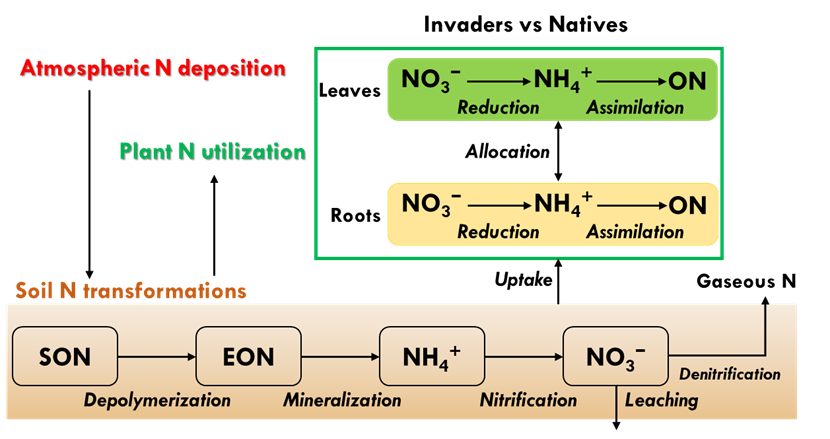Human activities have increased atmospheric nitrogen (N) inputs into terrestrial systems, which has changed the rates and fluxes of soil microbial N cycles, plant N sources and their absorption-assimilation strategies. These changes have further induced exotic plant invasions and affected the structure and function of terrestrial systems and regional environmental quality. However, due to the complex biological processes among different forms of labile N, the mechanisms of soil N transformation and plant N utilization and how they respond to elevated N deposition are still unclear. This hinders the evaluations on fates of anthropogenic N pollutants and effects of atmospheric N pollution.

Key processes of soil N transformations and plant N utilization
(SON: soil organic N; EON: extractable organic N; ON: plant organic N; NH4+: ammonium; NO3-: nitrate)
Recently, a research group, led by Prof. Xue-Yan Liu from the School of Earth System Science of Tianjin University, established a new set of isotopic frameworks to constrain the fractions and fluxes of soil N depolymerization, mineralization, nitrification, denitrification, and the contributions of soil ammonium and nitrate to total N assimilation of plant roots and leaves. Since the establishment of the bacterial and chemical methods for measuring N isotopes of different soil N forms in the 2000s (Sigman et al. 2000 Anal Chem; Koba et al. 2010 RCM, 2012 JGR; Weigand et al. 2016 RCM), Liu et al. developed the quantitive isotopic elucidation of soil microbial N transformations mentioned above (Xu et al. 2021 GBC). Since leaf δ15N was used to partition contributions of soil ammonium and nitrate to plant total N assimilation (Houlton et al. 2007 PNAS; Liu et al. 2018 PNAS; Hu et al. 2019 J Ecol), the method of Liu et al. re-considered δ15N differences between leaves and roots, isotope effects of mycorrhizal N absorption and leaf-root N allocation, therefore improved the assessment on plant ammonium-nitrate allocation and preference (Hu et al. 2022 STE). Based on these new methods, they analyzed δ15N of different soil N forms in forests under a wide range of N deposition in East Asia, and plant δ15N under different invasion degrees in Xishuangbanna, China, respectively. They have two key findings:
1) Increasing N deposition enhanced soil N depolymerization, mineralization, nitrification, but proportionally decreased total nitrate losses; and the contribution of denitrification relative to nitrate leaching for total nitrate losses increased with increasing N deposition. This study quantitatively evaluated how and to what extent increased N deposition promoted the microbial N transformations of forest soils (Xu et al. 2021 GBC).
2) The assimilation of N derived from both ammonium and nitrate was higher in leaves than in roots for invasive plants (Chromolaena odorata and Ageratina adenophora), leading to higher leaf N levels than native plants. Compared with the same species under no invasion, most native plants under invasion showed higher ammonium assimilations in both leaves and roots. Increases in leaf N were higher than in root N for native plants under invasion. This study informs that preferential N allocation, dominated by ammonium-derived N, to leaves over roots is a crucial N-use strategy for plant invasion and co-existence in the studied tropical ecosystem (Hu et al. 2022 STE).
These methodological innovations and critical scientific evidence enriched the cross-development of N isotope geochemistry and biogeochemistry and provided new evidence on the fates and effects of N deposition.
Article information:
Shi-Qi Xu, Xue-Yan Liu*, Zhong-Cong Sun, Chao-Chen Hu, Wolfgang Wanek, Keisuke Koba. (2021) Isotopic elucidation of microbial nitrogen transformations in forest soils. Global Biogeochemical Cycles, 36, e2021GB007070, https://doi.org/10.1029/2021GB007070
Chao-Chen Hu, Xue-Yan Liu*, Ya-Xin Yan, Yan-Bao Lei, Yun-Hong Tan, Cong-Qiang Liu. (2022) A new isotope framework to decipher leaf-root nitrogen allocation and assimilation among plants in a tropical invaded ecosystem. Science of the Total Environment, 86, 151203. https://doi.org/10.1016/j.scitotenv.2021.151203
Acknowledgments:
These studies were supported by the National Natural Science Foundation of China (41473081, 41522301, 41730855, 42125301, 42103075) and the State Key Project of Research and Development Plan (2016YFA0600802). The authors gratefully thank the help of Prof. Yan-Bao Lei from the Institute of Mountain Hazards and Environment, CAS; Prof. Yun-Hong Tan from Center for Integrative Conservation, Xishuangbanna Tropical Botanical Garden, CAS; Prof. Wolfgang Wanek from the University of Vienna; and Prof. Keisuke Koba from Kyoto University.